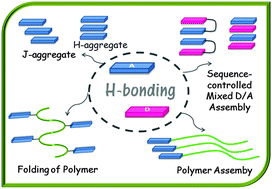H-bonding directed programmed supramolecular assembly of naphthalene-diimide (NDI) derivatives
Abstract
In this review we have collated various supramolecular designs, all surrounding H-bonding among well-known functional groups (peptides, nucleic acids, amides, ureas, carboxylic acids, pyridine-hydroxyls, urethanes, imides and others), to dictate self-assembly of naphthalenediimide (NDI) π-systems (both small molecules and polymeric building blocks) that exhibit several exciting features including strong propensity for π–π interactions, π-acidity, excellent n-type semiconductivity, CT-complexation, ion–π interactions, ring-substitution dependent redox properties and photophysical properties. This article reveals that H-bonding can indeed serve as a very powerful and versatile tool to programmed self-assembly of a single or multiple dye system producing a wide range of tailored soft materials, including fibrillar gels, chromonic mesophases, foldamers, nanotubes, vesicles, reverse micelles and polymersomes, both in water and organic medium with distinct photophysical properties, charge transport properties, conductivity properties and functional group displays that are highly relevant in the fields of biology and organic electronics.

- This article is part of the themed collection: 20th Anniversary of the CRSI: Celebrating Indian Chemistry in ChemComm

 Please wait while we load your content...
Please wait while we load your content...